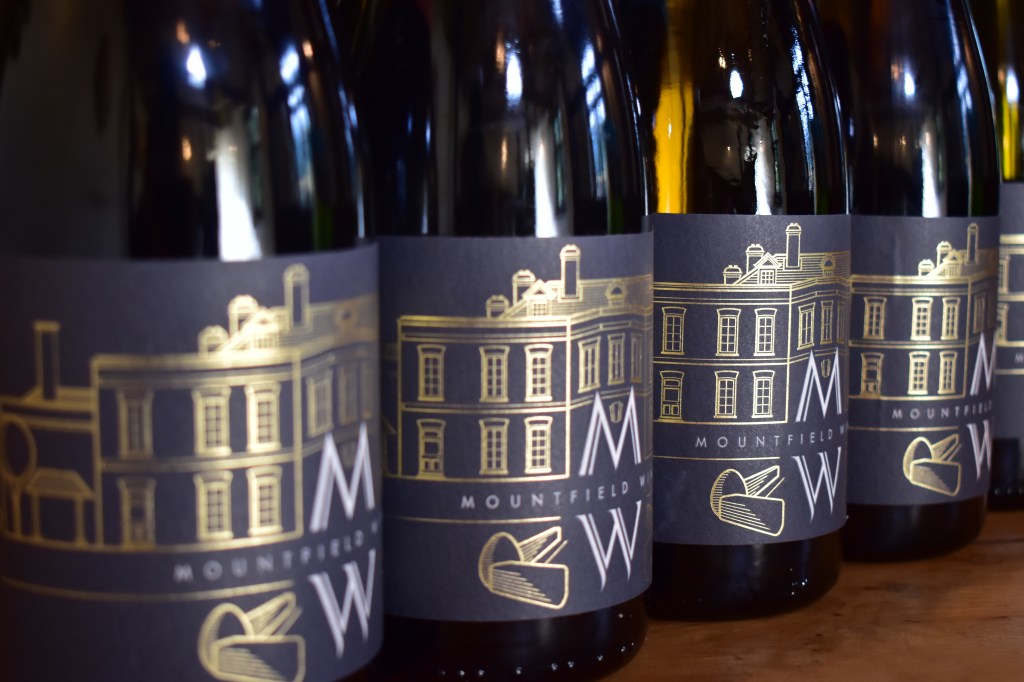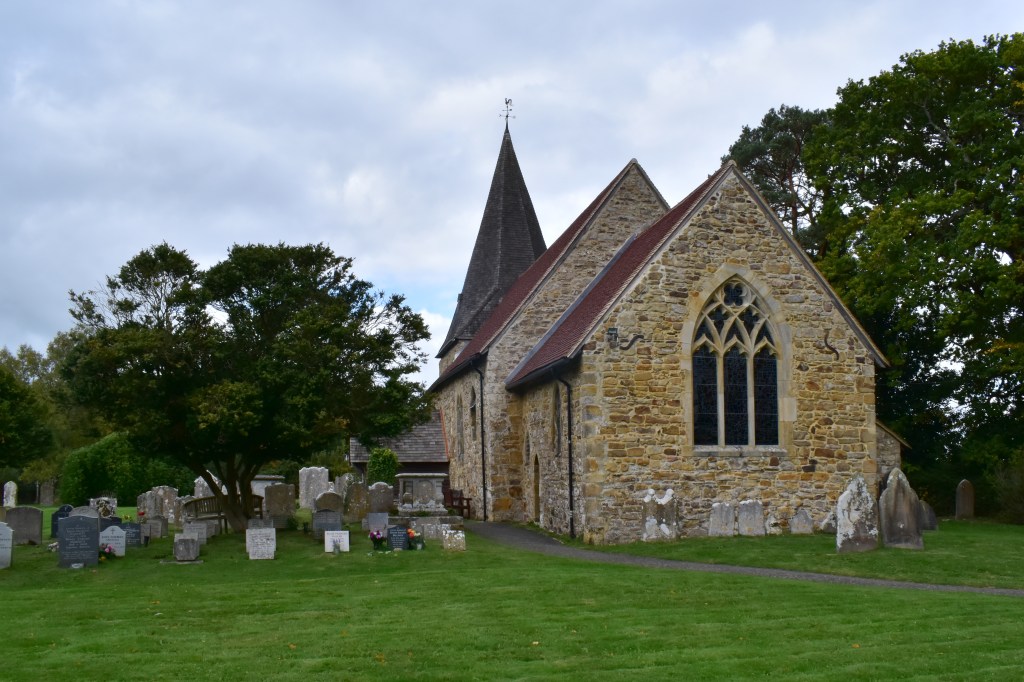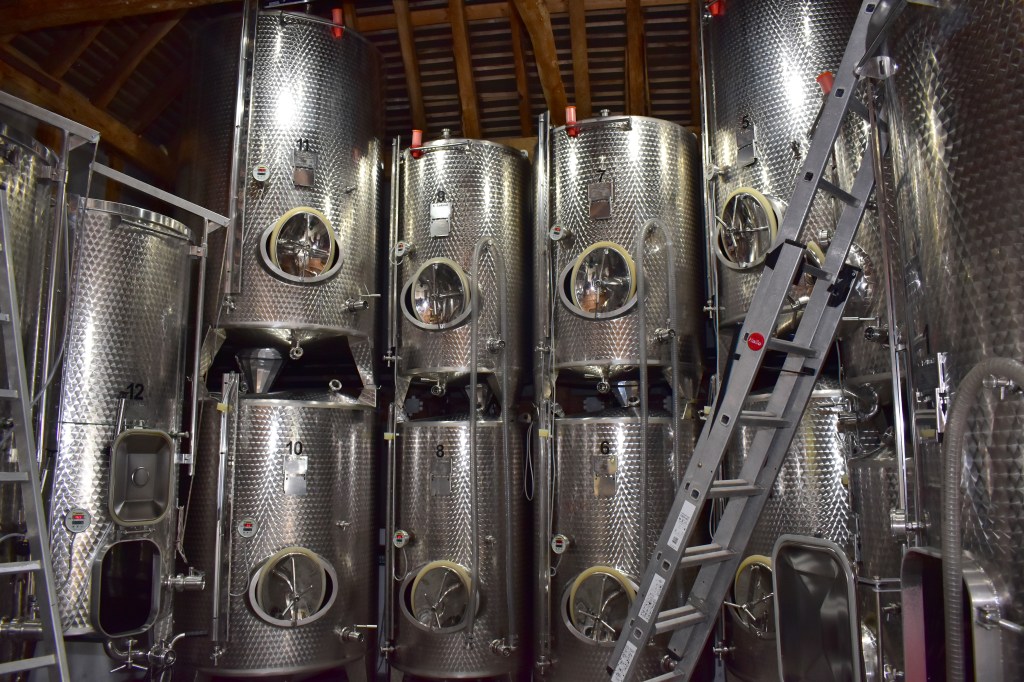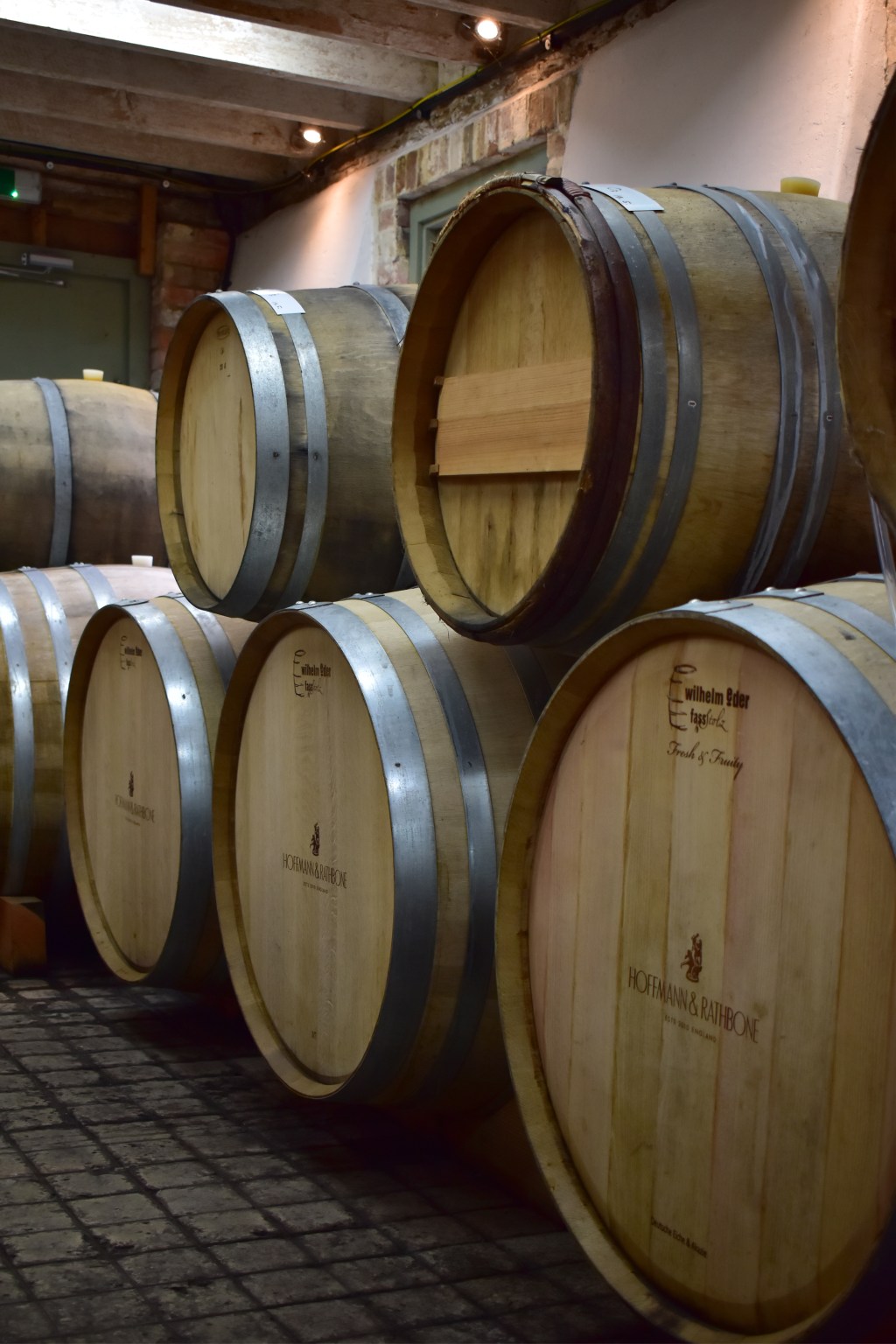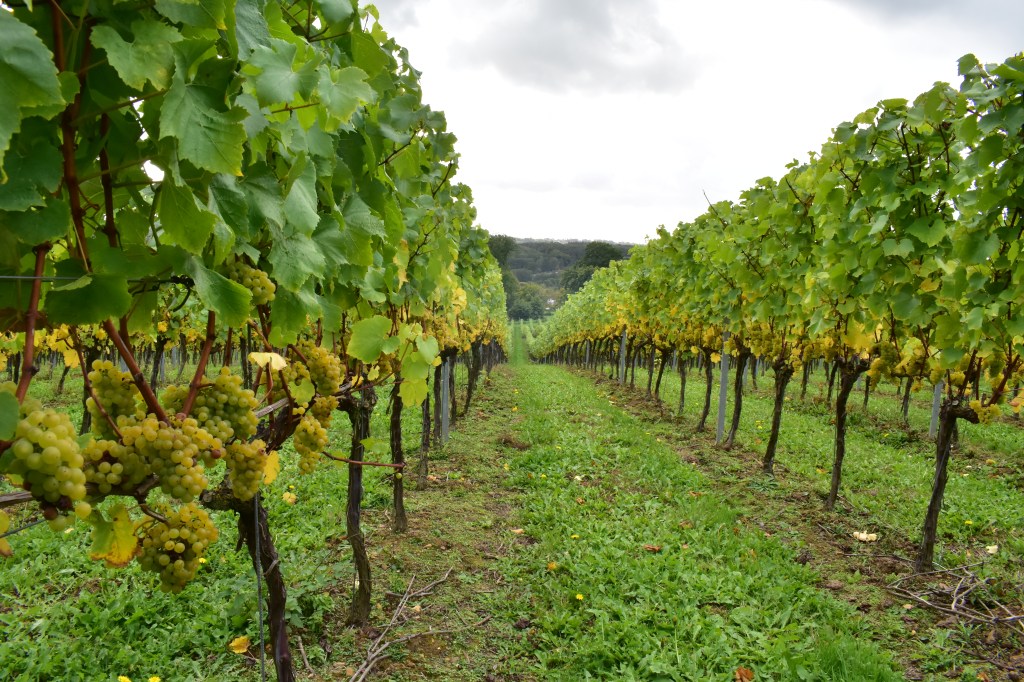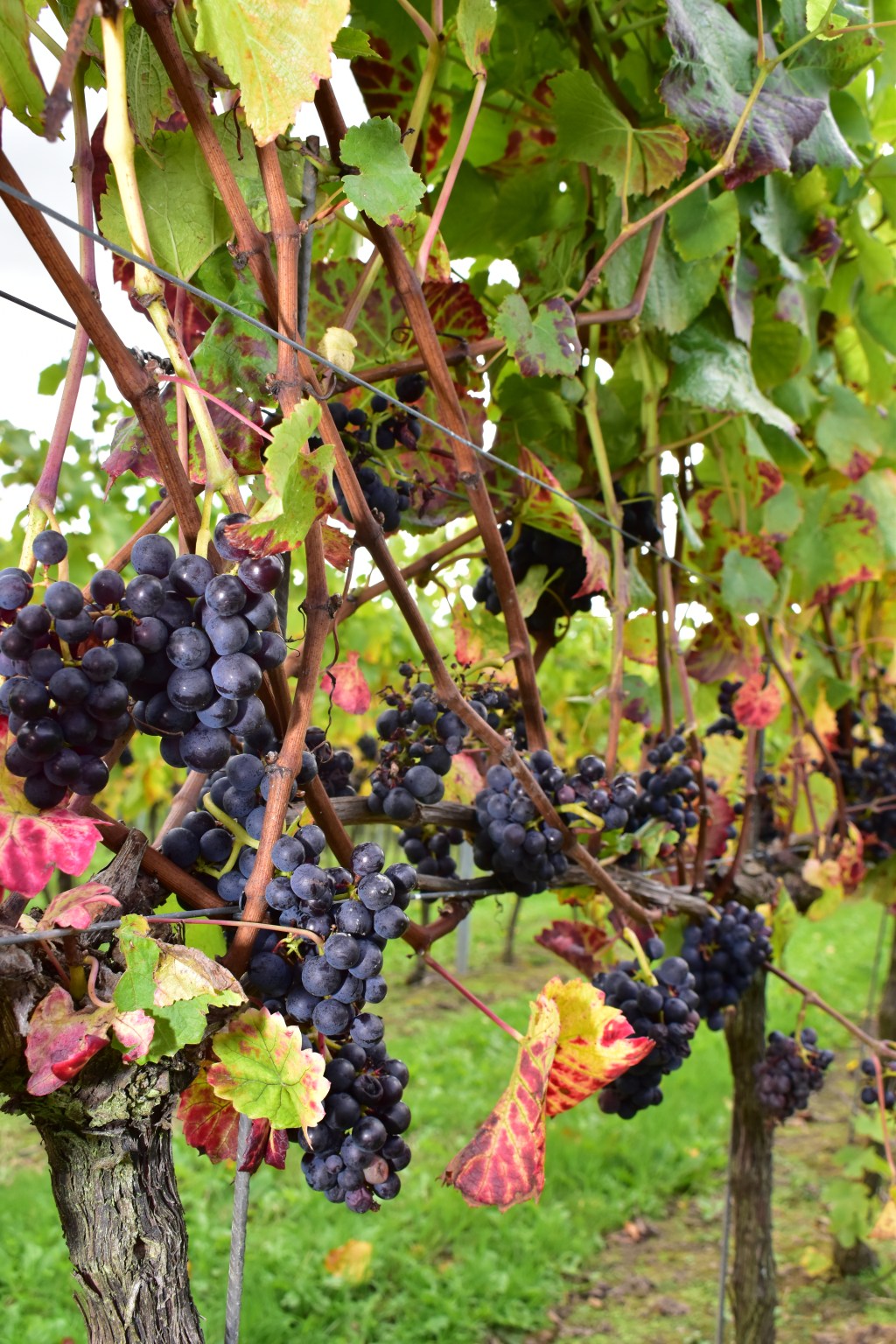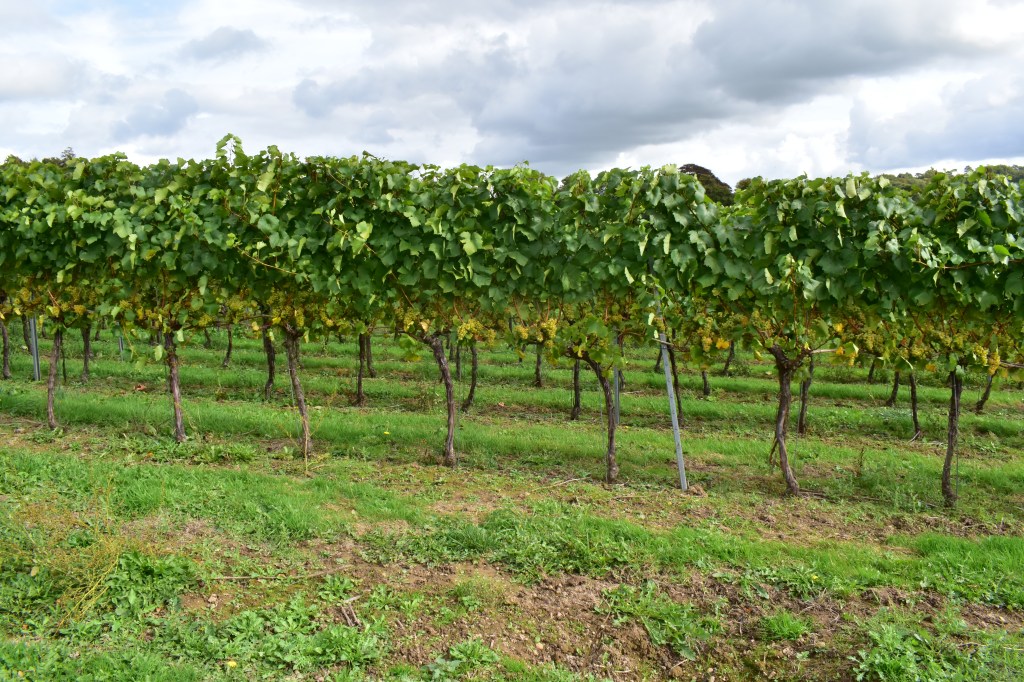Mountfield in East Sussex is a small village with deep roots. On the aptly named Church Road unsurprisingly you will find All Saints Church and a quick glance at the notice board reveals that the Grade II* listed building is celebrating its 900th anniversary. The church has a stained glass window that features a ploughing tractor in the design highlighting that this part of East Sussex has long had agriculture at its heart.
Opposite the entrance to the Church is the driveway that leads to Mountfield Winery which is marked only by a sign holding their label design. Simon and Lucinda Fraser have lived and farmed at Mountfield Court since 1995; the land has been owned by the same family since 1863.
Like many farming enterprises they have had to develop and diversify in order to survive. Redundant farm buildings have been brought back into operation as additional income streams for the arable enterprise and in 2012 Lucinda and Simon took the decision to plant 14,200 vines opting to plant the traditional sparkling varieties Chardonnay, Pinot Noir and Pinot Meunier with 50% of the planting as Chardonnay. Simon hinted that he did perhaps wish that they had planted some other varieties which would lend themselves to the making of still wines but he has no plans to expand the plantings. This is mainly because the vineyard is managed by Simon and he wants to remain hands on. Planting more vines would mean he would need more help; Simon and Lucinda want to keep their deep connection with the vines and wines. Part of the charm of Mountfield is that the whole process is carried out under the careful eye of Simon and Lucinda all on the same site. The grapes go from vine to bottle without travelling off site. Production is limited to 10,000 bottles, although the winery could make more, and the grapes travel only a few hundred metres to the onsite winery. It is not perhaps unique to have a small vineyard with its own winery but it is a rarity.
Whilst Lucinda has run the farm for many years Simon worked in the city. Eventually he decided that he would like to produce something on farm that included a manufacturing element. The couple looked at various options and together did lots of research. After consulting with the wine merchants Corney and Barrow they settled on the production of traditional method English sparkling wine. There were some old dairy buildings on the farm that were of no use for modern agricultural purposes and they decided to put in a winery to process the grapes from the Vineyard. The vines were imported from Germany with a 41B rootstock. “The soil type is Greensand and Clay on Sandstone and most vines in the area use SO4 rootstock so at first I was concerned that the vines would be over vigorous but in fact they have been brilliant. Generally the vines are very healthy and I only tend to call John Buchan the agronomist when I am in a panic,” said Simon.
During a tour of the vineyard Simon explained that there is usually disease pressure from downy mildew but this has not been a problem this season. On the other hand Botrytis has been a problem this year especially with the Chardonnay. “This is probably because the harvest has been postponed twice,” explained Simon. “The first time the acidity levels were not dropping and then when the fruit was ready the pickers were unavailable,” he added. Simon is very keen on leaf stripping for canopy management. “Just fruit and a nice canopy that helps on disease pressure, he said.” All the vines are stripped by hand. Simon explained that he had seen results from mechanical stripping which he felt: “Didn’t really look like it had been stripped at all because they were not aggressive enough on it.” The results Simon achieved by hand meant that the canopy remained green this year even with the late harvest date and the fruit was able to make use of any extra sunlight that was available.
The best crop from the vineyard came in 2020 when 32 tonnes were harvested. This year the vines will deliver between 25 and 27 tonnes. These will be harvested over two or three days with pickers provided by Vineworks. Simon initially thought there would be 22 pickers but during my visit he received a call to say the number has been increased to 30 meaning Simon will need to visit N P Seymour who are just down the road to acquire some more snips. Mountfield sell any extra fruit which is not used in the winery, this year the figure will be in the region of 15 tonnes of fruit.
In ten years the vineyard has never had a frost problem. Simon explained how he has tried to minimise the risk of frost and in the process reveals his deep connection to the landscape he said: “I removed some trees at the bottom which I hated doing but it was necessary to allow the air to flow.” There is now a clear view from the top of the vineyard down the gentle slope to where the Pinot Meunier is planted at the bottom and beyond to a field that is still in arable production (maize this year). Beyond the field there is a pond that Simon has dug out with the intention of removing cold air from the vineyard. This is designed as an extra frost prevention measure but Simon added: “With only the two of us what are we going to do when the frost hits at 3am?”
When talking about problems faced in the vineyard the discussion moves from disease to pests. Simon explained: “deer are a massive issue in the area.” Currently to protect the vines there is a substantial deer fence in place but this would cause significant problems if they were forced by a lack of pickers to move to a machine harvesting system. Whilst Simon is very happy with the results he gets by hand picking and whole bunch pressing if labour issues forced them to use machines then they would have to rethink the current deer protection as there is not enough room inside the current fence to manoeuvre a large machine. The other problem that the vineyard has is Starlings. Simon told me: “Surprisingly the Starlings have not shown any interest in the vines this year considering how ripe the fruit is,” literally as he is still speaking we are witness to a display of swooping Starlings right over the ripe Chardonnay grapes – commentators curse with only a few days until the pickers arrive.
Both Lucinda and Simon mention that it can be difficult for the small producers to get heard and that they can be overlooked as there are a growing number of large producers entering the English Wine sector. “The booze trade is a pay to play trade and the big guys have lots of money,” said Simon. “So we want to keep it boutique, top end and keep ourselves very much involved. We are really excited to have a product to sell that we believe in,” added Lucinda.
The conversation turns to the protection of the term Sussex and how that affects them as a vineyard. Simon makes the point that he is concerned about the term Sparkling Wine lacking any clarity for the consumer. It is a subject that has been discussed by the trade for many years. Sparkling as a term can be applied to a vast array of drinks including bottled water but as yet there is no definite solution to the problem. “Also high quality traditional method sparkling will, because of the cost of production, be more expensive and this could confuse consumers and lead to problems with quality assurance for high end producers,” said Simon. On the other side of the argument Simon stated that there is still more work to be done on the education of the consumer and although the move to protect high end producers is necessary it needs to be done at the right time when English and Welsh wine as a category has grown enough in stature to withstand what could cause fractures across the counties. Simon and Lucinda both agree that “the community was welcoming and friendly when they first planted their vines.”
Mountfield Winery currently have a Rosé Reserve 2017, the Classic Cuvée 2016 and a Blanc de Blancs 2015 which was released the day Vineyard magazine visited as was a Rosé Reserve 2015 Magnum priced at £88. Magnum bottles are always an impressive edition to a celebration and they look good on retailers shelves. During a tour of the wine store which currently holds between 60,000-70,000 bottles Simon explained: “The 2016 Classic Cuvée will sell out early in 2023 and the Rosé Reserve 2017 is nearly sold out.”
While many buildings around the vineyard have been repurposed (in fact the tasting room used to be the home of Lucinda’s pony) the wine store is a new building. “Rother council were very helpful throughout the planning process,” said Simon. To try and keep costs down Mountfield have invested in a 15kw solar array on top of the wine store. It only came online in October but they are hoping that it reduces the energy costs that have quadrupled recently. “This is a worrying cost for producers to absorb,” he said while he was checking the digital display to see how much electricity the new installation was generating. I asked if they would add money to the bottle price as a consequence of these rising input costs but Simon felt this was not possible.
Lucinda visits food festivals as an exhibitor showcasing their wines to the public. The gift boxes they offer with their wine at these shows are a really nice touch and prove popular with consumers. At these events Lucinda only offers two wines for tasting because “whilst the public facing events are enjoyable they can be quite busy and frantic,” she said. Since Lucinda is face to face with the public at these events I asked her how she feels people respond to the wines? “The wine people prefer is quite split almost 50/50 between the two wines I offer,” she answered. Twice a year the vineyard hosts an event at the cellar door and Lucinda said it is evident at these events that the people of Mountfield are happy and proud to have a vineyard in their parish. “The local people all come and support the winery which is really lovely,” she said. “Additionally we have had a pop up restaurant and a Christmas fair,” added Simon. During 2021 the vineyard started to offer wine tours which, like everything else at Mountfield, are conducted by Simon and Lucinda themselves. They have hosted international visitors and tours can be arranged by appointment but wine tourism is time consuming and with all the other jobs that need to be done on the vineyard and the farm the couple find it a difficult balancing act.
On the subject of awards Simon explained that: “They are very expensive to enter,” but that the Classic Cuvée was entered into the 2022 Champagne and Sparkling Wine World Championships (CSWWC) and won a silver medal. For a small producer entering a limited number of competitions this is certainly an achievement, but Simon and Lucinda want to let the wine speak for itself. The competition saw close to 1000 wines entered with 396 Gold and Silver medals awarded. Out of 21 countries that took part England found itself in fourth place in the medal table with the top spots still claimed by France and Italy.
In addition to events around the south east and also on their website (www.mountfieldwinery.com) the wines are also to be found on exclusive menus in the City. It is nice to hear that as small producers they are still finding their way onto wine lists at high end restaurants. As for the future Simon and Lucinda are hoping to distribute their wines internationally possibly looking to Scandinavia as a market that appreciates traditional method English sparkling wine.
In the winery we meet the winemaker Ulrich Hoffmann. Despite being incredibly busy Ulrich seems very calm. This is not surprising as Ulrich has worked in Sussex since the early 2000’s. It was whilst working at a vineyard as a summer job when he was a student that he first saw the potential for English wine. Ulrich describes his career as starting with “a classic German education as a winemaker encompassing a degree in Oenologie.”
Ulrich saw the opportunity to “make something outstanding” when he was approached by Mountfield Winery to make wines in the Sussex Weald describing the “superb clay soils and protected warmth retaining micro-climate” as the “right ingredients.” Mountfield wines are “based on percentages of reserve base wines aged in barrel going back five years giving the possibility of blending the fresh youthful recent vintage with the extraordinary complexity of mature wines,” he said. “Using reserve base wines as we do at Mountfield brings an extra dimension to the style we are looking to achieve,” he added.
About 20 white wine oak barrels are used in the winery but for Ulrich: “It is not about oak aromas or flavours but more about the complexity a barrique ferment can give a wine through the process of micro-oxidation.”
When asked about long lees ageing Ulrich said: “It really depends what you consider as long lees ageing. The key is to achieve the right acidity-fruit balance through ageing the wine, changing harsh gripping acidity to mouth-watering. The bottom line is creating a wine that needs little dosage and is balanced in every way.” I ask him what he is looking to achieve with the wines he makes for Mountfield and his response that he wants to put “a smile on the face of the person who drinks it” is a statement that encompasses the whole ethos of Mountfield Winery. From Simon in the vineyard and Ulrich Hoffman as the winemaker to Lucinda who takes the wine to the public the atmosphere at Mountfield Winery is one of enjoying the process of producing high quality wine; a heartfelt passion that is passed on every time a bottle is opened.


